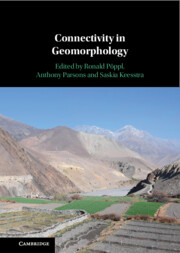Book contents
- Connectivity in Geomorphology
- Connectivity in Geomorphology
- Copyright page
- Contents
- Contributors
- Preface
- Acknowledgements
- Part I Introduction
- Part II Connectivity in Process Domains
- 3 Hillslope Processes
- 4 Fluvial Processes
- 5 Aeolian Processes
- 6 Glacial Processes
- 7 Periglacial Processes
- 8 Coastal and Deltaic Environments
- Part III Quantifying Connectivity in Geomorphology
- Part IV Managing Connectivity
- Index
- References
8 - Coastal and Deltaic Environments
from Part II - Connectivity in Process Domains
Published online by Cambridge University Press: 10 April 2025
- Connectivity in Geomorphology
- Connectivity in Geomorphology
- Copyright page
- Contents
- Contributors
- Preface
- Acknowledgements
- Part I Introduction
- Part II Connectivity in Process Domains
- 3 Hillslope Processes
- 4 Fluvial Processes
- 5 Aeolian Processes
- 6 Glacial Processes
- 7 Periglacial Processes
- 8 Coastal and Deltaic Environments
- Part III Quantifying Connectivity in Geomorphology
- Part IV Managing Connectivity
- Index
- References
Summary
Coastal rivers and deltas provide important ecosystem services, are hot spots of energy and food production and host hundreds of millions of people. These geomorphic features possess a wide range of spatial and temporal scales that need to be accounted for when analyzing the form of these systems. This form can be characterized by three types of connectivity: structural, functional, and process connectivity. Structural connectivity is driven by the physical adjacency of topographic elements; functional connectivity pertains to the transport processes that control the magnitude and directionality of fluxes of water, solutes, and solids across coastal landscapes, and process connectivity captures the variables and their interactions that define the system’s state. Connectivity and/or the lack thereof in coastal landscapes control the functioning of these systems; as such connectivity is a helpful framework that captures the structure, dynamics, and responses of coastal landscapes under future scenarios of climate and anthropogenic modifications so that these systems can be studied and restoration interventions optimally informed.
Keywords
- Type
- Chapter
- Information
- Connectivity in Geomorphology , pp. 162 - 190Publisher: Cambridge University PressPrint publication year: 2025

